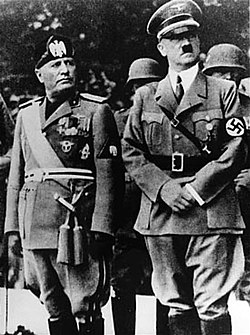The word dictator or despot in modern times is used to describe an absolute ruler of a country (other than a king). A dictator uses force and fear to keep themself, their friends, and their allies in authority.

They can effectively make laws all by themself. A country that is ruled by a dictator is called a dictatorship.
History
changeThe word "dictator" comes from the Roman Republic, where a man would be given absolute power for six to twelve months to handle an emergency. Julius Caesar was the last Roman Dictator.
Some dictators in history have gained political power through by violently taking over the existing government (for example, in a military coup, civil war or revolution). Others won an election, but once in power, they cancelled new elections or changed how they were run to make them unfair for opponents.
Differences: Kings and emperors
changeKings and emperors often use force and fear too, but usually they are not called dictators. This is because those monarchs have some reason for being in power (usually their father was king or emperor), but a dictator gained power himself. Also, when someone is king or emperor of a country, usually there were several kings or emperors before them. A dictator often creates the job of dictator by gaining power.
Some dictators start wars and/or kill millions. Mao Zedong, Joseph Stalin and Adolf Hitler are three of the deadliest dictators in history. Pol Pot was perhaps the deadliest: his Cambodian genocide killed nearly a quarter of the people under his rule.
List of dictators
changeThe most famous dictators in history include:
- Adolf Hitler (Nazi Germany, during WWII and the Holocaust)
- Bashar Assad (Syria,Fled away)
- Alexander Lukashenko (Belarus)
- Ali Khamenei (Iran)
- Ante Pavelić (Croatia)
- Augusto Pinochet (Chile)
- Benito Mussolini (Fascist Italy)
- Chiang Kai-shek (China)
- Deng Xiaoping (China)
- Enver Pasha (Ottoman Empire)
- Erich Honecker (East Germany)
- Ferdinand Marcos (Phillipines)
- Fidel Castro (Cuba)
- Fumimaro Konoe (Japan during WWII)
- Hideki Tōjō (Japan during WWII; convicted of war crimes)
- Ho Chi Minh (Vietnam/North Vietnam)
- Ion Antonescu (Romania during WWII; executed for war crimes in 1946)
- Joseph Stalin (USSR)
- Josip Tito (Yugoslavia)
- Juan Perón (Argentina)
- Kim Il-Sung (North Korea)
- Kim Jong-il (North Korea)
- Kim Jong-un (North Korea)
- Konstantin Chernenko (USSR)
- Lee Kuan Yew (Singapore)
- Leonid Brezhnev (USSR)
- Leopoldo Galtieri (Argentina)
Famous dictators in history. Row 1: Joseph Stalin, Adolf Hitler, Augusto Pinochet; Row 2: Mao Zedong, Benito Mussolini, and Kim Il-sung. - Mao Zedong (China)
- Mikhail Gorbachev (USSR)
- Miklós Horthy (Hungary)
- Muammar al-Gaddafi (Libya)
- Napoleon (France for five years, before he made himself Emperor)
- Nicolae Ceaușescu (Romania)
- Ngo Dinh Diem (South Vietnam)
- Nikita Khrushchev (USSR)
- Pervez Musharraf (Pakistan)
- Pol Pot (Cambodia)
- Raúl Castro (Cuba)
- Rhee Syng-man (South Korea)
- Ruhollah Khomeini (Iran)
- Saddam Hussein (Iraq; executed)
- Slobodan Milošević (Yugoslavia)
- Suharto (Indonesia)
- Todor Zhivkov (Bulgaria)
- Vladimir Lenin (USSR)
- Wojciech Jaruzelski (Poland)
- Xi Jinping (China)
- Yuri Andropov (USSR)